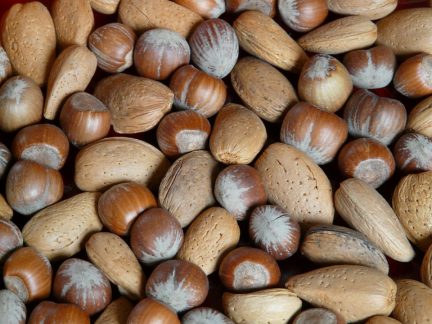Tree Nuts are one of the most potent allergenic foods in proportion to the amount that can set off a severe reaction. Keeping your facility free from contamination by this common allergen is very important if you are complying with FDA labeling guidelines, especially given the rise in recalls due to allergen contamination. One important distinction: while peanut is a common allergenic, it is not a tree nut.
Tree nut allergies are some of the most common among both adults and children, and reactions can be severe and even life-threatening. In a 2001 article published in Journal of Allergy and Clinical Immunology, fatal food reactions in the United States attributable to Tree Nuts accounted for 31% of all allergy-deaths, and all of the fatalities in patients under six years of age.
Tree nuts include, but are not limited to, almonds, Brazil nuts, cashews, chestnuts, filberts/hazelnuts, macadamia nuts, pecans, pistachios, pine nuts, and walnuts.
What is the root cause of a tree nut allergy?
The proteins responsible for allergic reactions to Tree nuts are diverse and include the seed storage proteins (vicilins, legumins, albumins), plant defense related proteins and profilins.
Who is affected?
 It’s estimated that Tree Nut allergy in the United States affects about 1.1% of the general population. It is likely that Tree Nut allergies span a lifetime. Less than 10% of children outgrow it, compared to 20% outgrowing a peanut allergy. There is significant cross-reactivity to all types of tree nuts, so allergy to one type of nut makes it likely that others will also cause a reaction. As with any other allergy, there is no cure and the only recommendation is avoidance.
It’s estimated that Tree Nut allergy in the United States affects about 1.1% of the general population. It is likely that Tree Nut allergies span a lifetime. Less than 10% of children outgrow it, compared to 20% outgrowing a peanut allergy. There is significant cross-reactivity to all types of tree nuts, so allergy to one type of nut makes it likely that others will also cause a reaction. As with any other allergy, there is no cure and the only recommendation is avoidance.
What are some unexpected sources of Tree Nuts
Tree Nut proteins may be found in a surprisingly large number of ingredients, including cereals, flavorings and marinades, as well as barbeque and other sauces. Some alcoholic beverages may contain nut flavoring or are made from nuts. Since these beverages are not currently regulated by FALCPA, contact the manufacturer to determine the safety of any alcohol used as an ingredient.
- Black walnut hull extract (flavoring)
- Natural nut extract
- Nut distillates/alcoholic extracts
- Nut oils (e.g., walnut oil, almond oil)
- Walnut hull extract (flavoring)
- Enchilada sauce
- Marzipan
- Mole sauce
- Barbecue sauce
- Maraschino cherries (almond)
- Mortadella may contain pistachios
- Pesto (pine nuts)
- Some alcoholic beverages can be made or use flavorings derived from nuts
Did you know?
- Tree nuts are a hard-shelled fruit and should not to be confused or grouped together with peanut, which is a legume, or seeds, such as sunflower or sesame.
- The American College of Allergy, Asthma & Immunology (ACAAI) states: “Coconut is not a botanical nut; it is classified as a fruit, even though the Food and Drug Administration recognizes coconut as a tree nut. While allergic reactions to coconut have been documented, most people who are allergic to tree nuts can safely eat coconut.”
- The federal Food Allergen Labeling and Consumer Protection Act (FALCPA) requires that all packaged food products sold in the U.S. that contain tree nuts as an ingredient must list the specific tree nut used on the label.
What are typical symptoms of a Tree Nut allergy?
Since adverse reactions to Tree Nuts can be triggered by minimal amounts of the food (sometimes even by skin contact or inhalation), strict avoidance is imperative. Cross contamination is the biggest issue when it comes to challenges in manufacturing.
- Abdominal pain, cramps, nausea and vomiting
- Diarrhea
- Difficulty swallowing
- Itching of the mouth, throat, eyes, skin or any other area
- Nasal congestion or a runny nose
- Nausea
- Shortness of breath
- Anaphylaxis
AlerTox Sticks Almond and Hazelnut
AlerTox Sticks kits are specially designed to help food manufacturers monitor levels of common allergenic proteins at every step of production and in a variety of matrices. As with all of our tests, the kits are easy to use, accurate, and robust.
AlerTox Sticks Almond
AlerTox Sticks Almond detects one of the main almond allergens: a specific fragment of prunin/amandin protein (legumin-like 11S seed storage protein, allergen Pru du 6).
AlerTox Sticks Almond does NOT detect the antigens of cereals, legumes and other nuts, including walnut, pecan, peanut, hazelnut, cashew, macadamia, Brazil nut and coconut.
PLEASE NOTE: the test shows considerable cross-reactivity in pit extracts of the fruits of Prunus and related genuses: peach, plum and apricot. If these pits are crushed during industrial processing of fruit masses (for example, in production of jam), the resulting material may show false positivity with AlerTox Sticks Almond.
AlerTox Sticks Hazelnut
AlerTox Sticks Hazelnut detects one of the main hazelnut allergens: corylin (legumin-like 11S seed storage protein, allergen Cor a 9).
AlerTox Sticks Hazelnut does NOT detect the antigens of cereals, legumes and other nuts, including walnut, pecan, peanut, almond, cashew, macadamia, Brazil nut and coconut.
No cross-reactivity is observed.
Learn More About Tree Nut Allergy
- Tree Nuts Allergy on the Food Allergy Research and Resource Program site
- Allergy information for Almond on InformAll
- Allergy information for Hazelnut on InformAll
- Register on Allergence for reporting and recalls of foods containing undeclared allergens.


